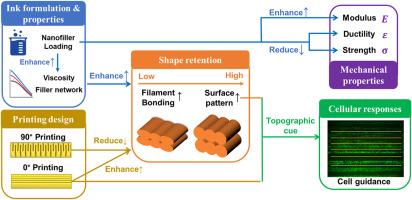Direct ink writing of bioactive PCL/laponite bone Implants: Engineering the interplay of design, process, structure, and function
引用次数: 0
Abstract
Direct ink writing (DIW) is a room-temperature extrusion-based 3D printing technique that enables the fabrication of dense, customizable implants from viscous inks with precise spatial control. In this study, we present an engineering design framework for DIW-printed PCL/Laponite composites by tuning ink formulations and printing orientations to systematically investigate and control the complex interplay between shape fidelity, mechanical performance, and cellular response. Our findings show that printing at 0° orientation enhances filament-aligned surface topographies, which guide osteoblast attachment and significantly promote cell proliferation and mineralization. In contrast to previous studies using fused deposition modeling (FDM), we observe that printing at 90° orientation (perpendicular to the tensile load direction) results in higher mechanical performance due to improved filament bonding. Increasing Laponite loading (up to 30 %) improves shape retention by increasing ink viscosity, raises Young's modulus by up to 110 %, and enhances surface bioactivity by introducing hydrophilic and bioactive cues. This study provides a tunable strategy for engineering bioactive and surface-active implants for the clinical need for non-load-bearing orthopaedic applications where structural integrity, surface-mediated osteointegration, and customized geometry are clinically essential.

生物活性PCL/laponite骨植入物的直接墨水书写:设计、工艺、结构和功能的工程相互作用
直接墨水书写(DIW)是一种基于室温挤压的3D打印技术,可以通过精确的空间控制,用粘性墨水制造致密的、可定制的植入物。在这项研究中,我们提出了一个diw打印PCL/Laponite复合材料的工程设计框架,通过调整油墨配方和打印方向,系统地研究和控制形状保真度,机械性能和细胞响应之间的复杂相互作用。我们的研究结果表明,0°取向的打印增强了细丝排列的表面形貌,从而引导成骨细胞附着,显著促进细胞增殖和矿化。与之前使用熔融沉积建模(FDM)的研究相反,我们观察到在90°方向(垂直于拉伸负载方向)上打印由于改善了长丝粘合而具有更高的机械性能。增加拉脱石负载(高达30%)通过增加油墨粘度来改善形状保持,将杨氏模量提高高达110%,并通过引入亲水性和生物活性提示来增强表面生物活性。该研究为非承重骨科应用的工程生物活性和表面活性植入物的临床需求提供了可调策略,其中结构完整性、表面介导的骨整合和定制的几何形状是临床必需的。
本文章由计算机程序翻译,如有差异,请以英文原文为准。
求助全文
约1分钟内获得全文
求助全文

 求助内容:
求助内容: 应助结果提醒方式:
应助结果提醒方式:


